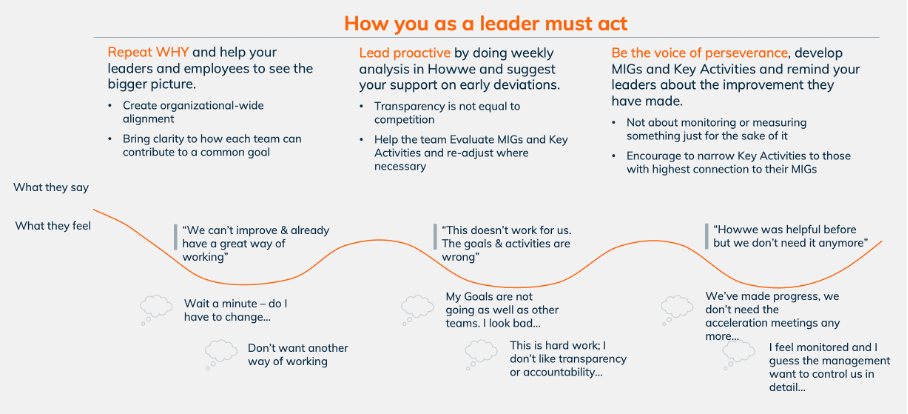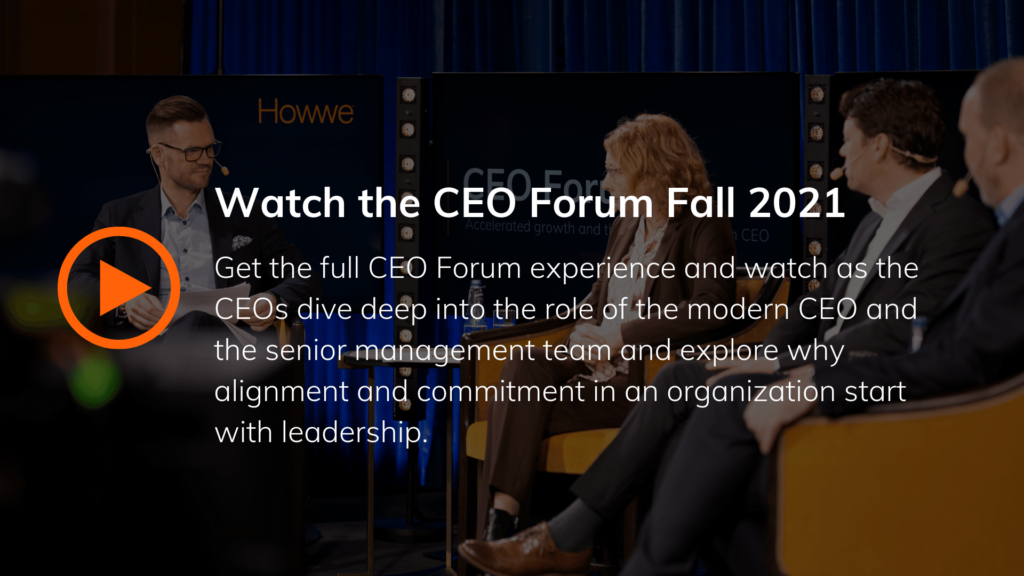Patrik Parnfors, Vice President at Howwe Technologies and moderator of the forum, together with the panelists Kajsa Hedberg, CEO of St1 Biogas, Jonas Hernborg, CEO of Elitfönster, and Klas Tockling, Vice President of Caverion Sweden, answering your questions.
The theme of the latest edition of CEO Forum, “Pick your path – the role of the modern leader” really spurred engagement from the audience. We received a great number of questions from the audience that deserve to be put in the spotlight. We’ve gathered all your questions together with answers from the panelists and the team behind CEO Forum in this article.
Prefer to listen to the Q&A from CEO Forum?
In this episode of the Howwe podcast, you will find all of the questions and answers from the CEO Forum Fall 2021 by Johan Grönstedt, Chief Strategy Officer at Howwe Technologies.
What has been the biggest issue in your management team and how did you solve it?

Kajsa Hedberg, CEO of St1 Biogas
Kajsa: I think that the biggest challenge has been that some members of my team have been reluctant to change. They feel, quite rightly, that they have been working and driving in the same way for several years and it’s been working for them. Why fix something that’s not broken?
I’ve tried to put it in a bigger picture of what’s happening in our environment and that we might need to make larger changes in order to stay competitive. So it’s not necessarily that your ways haven’t been successful for our previous state – it’s more a discussion on what we need to do moving forward.
For us, ultimately it comes down to that seeing is believing. When we started to have other voices than mine arguing for that increased transparency is good not only for my own team but also to tell a story to the whole company around the value our team creates and how it helps people to get more into action, and how engaging this process is for the whole company – this is when I found the discussion opened up and currently I feel that we are united as a management team.
It sounds like a quite detailed way of steering the organization, is this micro-management?
Kajsa: It depends on how you want to see it. In some ways, every individual manages themselves in line with the whole strategy.
On the other hand, you are correct in the fact that I got many reactions from my organization at first along those lines. Like, “are you going to control me?”.
The trick is to flip this mindset for everyone to understand and ask themselves “how can I contribute?” and take pride in being part of something bigger. We found that this builds a lot of commitment within our teams. It makes it more fun to go to work.
So initially, it is a fear, but when you discuss internally and make everyone experience the benefits, they quickly realize that it’s not a way to control them. It’s more like the step counter I carry on my wrist. My personal goal is to have 10 000 steps a day and currently, I only have 1000. To me it is a nudge to support me in prioritizing taking a walk over lunch, something I both enjoy and know is good for me in the long run. It’s not like I don’t want to do it, it’s just that some days I lose track of my goals and priorities. There I like that nudge that these types of tools can provide. Not because somebody controls me, but because I want to do it for myself.

Klas Tockling, Vice President of Caverion Sweden
When implementing Howwe, how do you tackle employees’ potential reluctance toward being monitored on an individual level, considering that Caverion has everyone involved?
Klas: Everyone is doing their reporting in the app. The staff takes on commitments to activities in our weekly meetings and then we follow up. Basically, it’s done in a very easy way. It only takes 2-3 minutes. It’s a small resistance for what you gain.

Jonas Hernborg, CEO of Elitfönster Sweden
You have an organization with both white and blue collars. How does the Howwe way of working align in the organization with daily steering, for example, Lean and 5S?
Jonas: When you’re running a production facility, there are endless operational parameters you try to optimize on a daily basis.
The primary tool is the daily steering within the LEAN framework and that’s really running your typical day-to-day stuff.
However, you can’t rely only on the day-to-day tools, you need to connect this also to where we are heading and a lot of time the behavioral change we need to do overtime – which is more on a strategic level. Howwe adds the strategic direction of where you want to go. Basically, you can say that the daily steering is the instrument panel of the car but Howwe is used as your GPS to get them going in the right direction and get the behavior of going in the right direction for the company and the people working there. They complement each other and we need both.
How does Howwe align with other reporting to the board, time, and what to report?
Jonas: I’ve used it to make it easier for both me and for the whole organization. I’ve come to realize that we rely on too many systems, meetings and PowerPoints when aggregating the information that I need for the conversations I have with the board. It is both very time consuming and doesn’t necessarily lend itself for the transparency that both me and the board wants. Currently I use Howwe as the basis for reporting progress on my strategy towards the board.
Print screens and some summaries that I get from my Howwe team has replaced all powerpoint reporting currently. Since this is such a helpful tool for me, I’m in close dialogue with the team from Howwe to further develop the report system to suit also what I need moving forward. This is equally true towards my organization, especially for the different strategic initiatives that report directly to me. I don’t want us to spend time creating slides and actually I don’t want that amount of flexibility.
The reason is that I want a streamlined process between the teams and in front of me to be able to clearly understand the progress versus the plan. I mean, any one can make nice slides to look good, we need to understand and discuss the real progress beneath all that facade.

Johan Grönstedt, Chief Strategy Officer at Howwe Technologies
Does Howwe also work with blue collars on an individual level?
Johan: Simple answer Yes, of course!
A more nuanced approach would be to say that there are some differences between white and blue collars that adapt the way Howwe is used in practice. But let’s start with some similarities. Everyone, no matter who you are and where you work, needs the same clarity around goals, wants to contribute to both what they focus on and how they intend to reach their goals. This means that the concept of setting the Most Important Goals and building actionability through Key Activities makes sense for all.
However, blue collars more often lack their own work-PC meaning that the Howwe mobile reporting app is their main tool. The app is great, so the friction is low with this tradeoff in practice.
From a cultural standpoint sometimes we hear a hesitancy from senior management on how a performance tool would be welcomed, specifically from their blue-collar organization. To our experience, this reluctance is more in the minds of senior management and has less to do with reality. Again, everyone appreciates clarity and the higher involvement with the company’s overarching goals that Howwe enables. A positive atmosphere arises together with a sense of community when everybody is striving for the same goals.
Caverion, you have returned to using Howwe. What happened to the group that stopped using Howwe?
Johan: Sadly Klas didn’t have the chance to answer this question live at the CEO Forum, but we’ve interviewed both him and other Howwe alumns around the period directly after Howwe was dropped.
The general insight is that the acceleration meetings quickly become quite vague, and the accountability around the most challenging changes suffers. Step by step, the progress is lost, although many reports that some core cultural aspects remain, most notably the willingness to continue to prioritize within goals.
Klas is only one CEO that we have been happy to welcome back with open arms over the years, and although we of course wished that they never lost acceleration in the first place, we are pleased with their continued and even stronger commitment to the future.
What are some of the challenges that I should expect on this journey as a senior manager, and do you have any general advice on how to deal with them?
Johan: A similar question was posed to Kajsa at the live event, but we would like to offer some advice based on our experience across hundreds of senior teams.
Here is a visualization of the three most common hesitancies and our best practice in how to handle them:

What is the biggest cultural impact on your management team?
Johan: One thing I love to do is to ask before and after questions to our clients. What really is the difference? In my experience, the cultural shift is the most apparent one. We sometimes refer to a culture of commitment, let me elaborate a little bit about what this implies.
When I talk to management teams that have not yet started with the Howwe journey, they often share these three complaints about their culture:
- Too many long conversations result in too few concrete actions resulting in very inefficient meetings and unclear decisions and ownership
- Too little progress is being generated between meetings, meaning that the same old topics are being brought up repeatedly
- We operate as siloed functional managers, rather than as one management team
The culture of commitment arises when the discussion is more focused on what truly matters, meaning what is most important also gets most of the time and focus available.
Second, it is not being discussed in general terms, but rather from a perspective of: Why do we need to do it, when do we need it done by, who needs to do it and what is the definition of done?
Thirdly, driving these initiatives through the Acceleration Meeting ensures that progress is continually done, meaning that if your management team meeting cadence is naturally monthly, you commit and follow up on these Key Activities on a weekly basis, ensuring continuous progress between meetings.
Lastly, by keeping priorities narrow and focusing together building from top-down as one team we can both optimize for cross-functional synergies and keep each other accountable creating a more engaging and involved culture. It starts from the top, but is positively contagious to other teams looking at us for that leading example!
Implement Howwe, is it recommended to run a pilot firstly, then follow up, and thereafter consider implementation all across?
Johan: This depends on your baseline. If your organization is somewhat adept at goal steering you can consider an all across implementation from the get-go. The main benefit of this approach is the speed of acceleration.
If you however are new to the area of goal steering or have a feeling that you might encounter some cultural hesitancy a pilot is a good approach to build some internal ambassadors and know-how around the way of working before expanding.
Do you see any differences in the leadership/management style when you are driving change in different countries (SE/DK/FI/NO and so forth)? Do you need to adjust the style or strategy to different cultures?
Johan: The Nordic countries, and especially Sweden stand out in consensus-seeking before embarking on a change journey. On the other hand, once consensus is gained, the convention is to support the change stronger over time than for example more top-down conforming cultures such as the Eastern European cultures or the US.
There is for sure a style change needed to conform to the different cultures. However, some of the more traditional top-down cultures seem to be changing over time. If you look to the coasts of the US culture, there is a demand for a more bottom-up involvement and in Japan, there are big talks about how the younger generations refuse to conform to the traditional values and are putting big pressure on older managers.
I think you could write many books on the topic, so it is difficult to give some general insight here, and my personal experience is that where the company HQ is located also plays a massive role in the company culture.
However, taking a more pragmatic approach, values such as being clear on Why the change is necessary, not only for the company but also for your team members is always key. Providing focus to your team(s) on what matters always improves performance and reduces stress. Involving members in the “how do we get there” discussion seems to be universally engaging and tends to bring out smarter ways to the goals than senior management on average can produce, especially when you get into the details. And finally, as a manager to provide enough recognition and feedback along the way seems to hold value no matter the culture.
So yes. And No. Good luck!
Can you see any challenges for the users in implementing a further layer of applications, like, “one more application to register in” and/or “one more application to use for following up”?
Johan: For sure there are general hesitancy both for more products in general and especially if there is a feeling that I have to report the same activity in multiple systems.
However, this question mostly comes from non-customers to our experience, we seldom get it from real-life clients. The most apparent reason to my knowledge is that although reporting is a chore no matter how you look at it, there are a couple of things that dilute that feeling for the users:
- Most times the Key Activities you identify as most impactful to drive your Most Important Goal is not necessarily part of your everyday whirlwind and you don’t seem to either track or have system support to optimize, meaning that the percentage of users that actually end up “double-reporting” is exceedingly low.
- To look at Howwe as a reporting tool is similar to looking at a car and saying that I don’t really like the look of that spare tire. There are way more going on that are well appreciated by the end-users. From the way you are being involved in the company direction in the onboarding phase to the way that the word prioritize goes from meaning “one extra thing my managers wants attention on” to “this truly matters” and to the way that the average manager suddenly becomes way better at providing clarity, recognition and feedback are way more important to the user experience of strategy execution than the act of reporting.
- And oh yeah, the reporting app is super simple, so it takes less than a minute per week to report. This is difficult to know as an outsider of course, but really – it’s not that big of a chore.
- Most times the Key Activities you identify as most impactful to drive your Most Important Goal is not necessarily part of your everyday whirlwind and you don’t seem to either track or have system support to optimize, meaning that the percentage of users that actually end up “double-reporting” is exceedingly low.
Can you give a good example of a goal and a bad example of a goal?
Johan: We have loads of proven goals combined with highly impactful Key Activities honed by real teams in real life in our Howwe Library. This is one of the great advantages Howwe clients get over the average company embarking on this journey without Howwe.
But here are some general rules for great goals:
- No team should focus on more than two Most Important Goals at a time
- Each Most Important Goal should have a clear, measurable target and timeline
- Each employee can provide input on the Most Important Goal for their team
- Each MIG should ladder up to or influence the company’s overarching MIG
And on the opposite bad goals are either too many, too vague (i.e. we want to be a great place to work – how great, when do we need to become great, what part of great, etc?) or generally not aligned within the company.
The importance of focus and talking with one voice was mentioned. A risk is that you lose open-mindedness and ambiguity is part of the organizational development. How do you reason about that?
Johan: Any action has consequences, the deeper question becomes what consequences you would prefer. To the extent there are some simple answers to the question, the “scientific consensus”* quite clear that there is more to win by creating clarity in what is most important versus letting the organization decide somewhat ad hoc and uncoordinated.
This does not necessarily mean that there are no negative consequences around clarity and focus. One area as the person asking the question points out might be open-mindedness and maybe agility to pursue opportunities arising along the way. In the Howwe way of working we combine long-term planning (typically setting the Most Important Goals) with shorter-term iterations on how to reach that goal (typically in a sprint process).
Finally, if I may add a personal note, I think there is a bias towards thinking that whatever “pops up” is more important than it actually is. I, probably together with most of you, make new years resolutions. My most recurring one is to read more.
Even though I know that this gives me more life fulfillment than whatever else tends to occupy my time if I were to do a time study on myself, I tend to prioritize less consistently and less value-adding activities. So if I had to choose, I would rather stick to my plan than have too much freedom to follow more open-minded and opportunistic pursuits.
* There are multiple organizations that are driving this body of research, ranging from the economic & psychological university departments and to management consultants studying what techniques seem to bear the strongest effect on real-world improvements. In our CEO Forum page, we reference what research our different practices are based upon.
What are you waiting for?
Howwe is the Solution for Growth.
With our method and software, we simplify the execution of your strategy.





